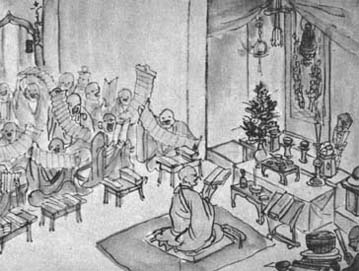I was wandering around the interwebs when I found myself returning once again to the Sotoshu website, the site for the Japanese Buddhist church from which my own practice and ordinations derive.
In the section titled “What is Sotoshu” I found an interesting summation of spiritual texts upon which the school relies. They state:
“We recite various Buddhist sutras, including the Meaning of Practice and Verification (Shushogi), the Heart of Great Perfect Wisdom Sutra (Hannya Shingyo), The “Avalokiteshvara Boshisattava Universal Gateway” Chapter of the Lotus Sutra (Kannongyo) and the “Life Span of the Tathagata Chapter” of the Lotus Sutra (Juryohon).”
Now, they do state at the beginning this list “includes” so it shouldn’t be thought of as comprehensive. Still, these are the texts they cite. So, these are important to the editors of the official page for the denomination.
The first of these texts listed is the Shushogi, which can be considered a summation or epitome of Master Eihei Dogen’s teachings. Here is a version of that text.
The second is the Heart Sutra. Here is a version of that text (together with a brief reflection).
The third is the 25th chapter of the Lotus Sutra, in Japanese the Kannongyo. Here’s a version of that text. (Closely related and frequently chanted is the Ten-Line Kannon Verse. This verse is of uncertain origin, but may have been a Japanese Tendai composition intended as a summation of the Lotus Sutra chapter.)
And the fourth is another chapter from the Lotus Sutra, the sixteenth, in Japanese the Juryohon. Here’s a version of that text.
The first two are fairly obvious choices for anyone with even a passing interest in Soto Zen. While controversial in some circles, the Shushogi is an attempt at summarizing the teachings of the most important theologian (if you will) in the tradition. And the Heart Sutra strikes to the very core of Zen’s spiritual assumptions.
The other two texts are less obvious choices for the average Western Zen student. And, therein, a challenge. Given the rationalist inclination of many, probably most Western Zen practitioners, how are these two texts to be engaged? If these four are the summary texts, what, how are these Lotus Sutra texts to be engaged?
A challenge. An invitation.
Sort of like a koan…













